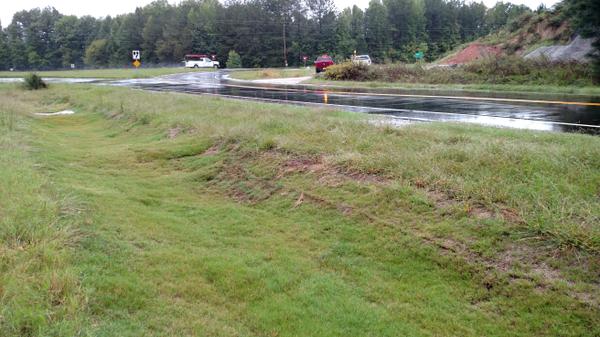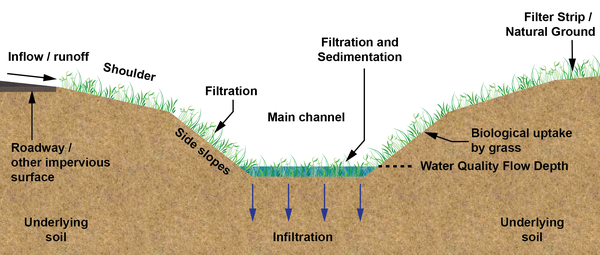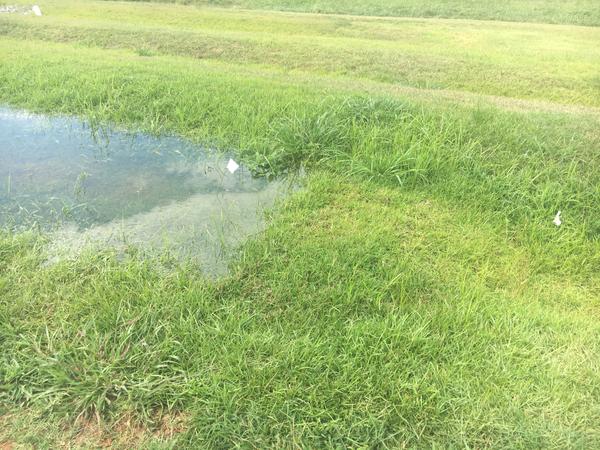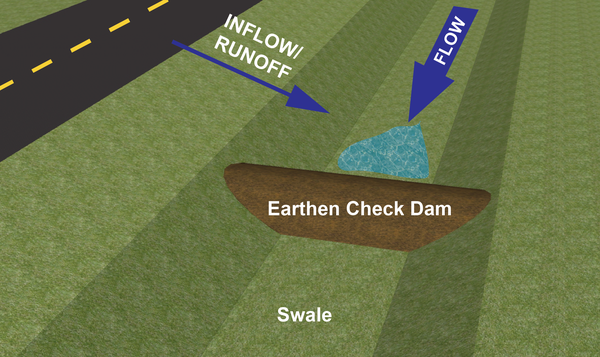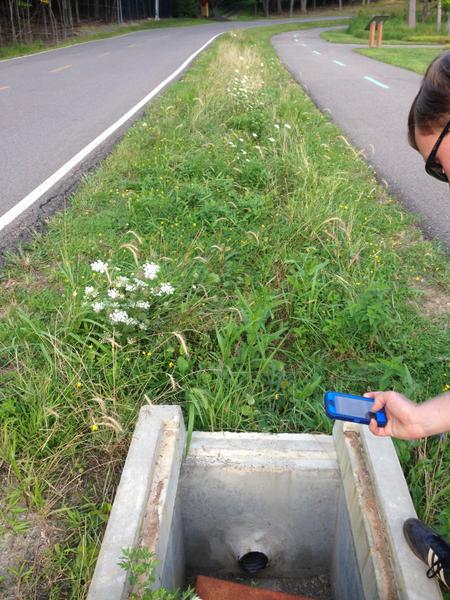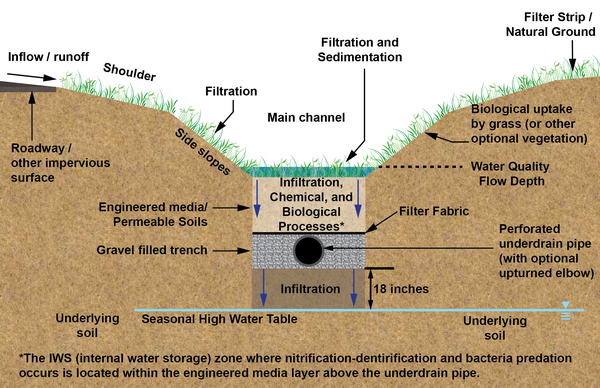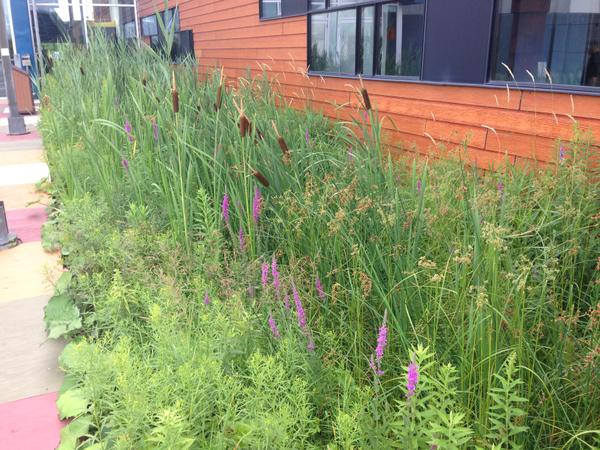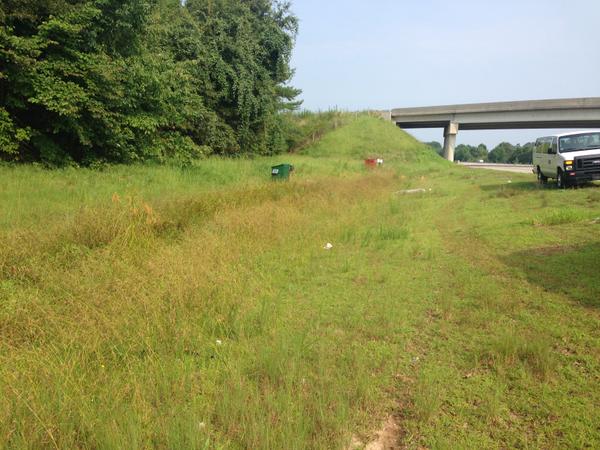Introduction
Swales are one of the oldest and most common forms of urban drainage and stormwater conveyance in the world (Burian and Edwards 2002). Grass swales are historically the most common stormwater control measure (SCM) for managing roadway runoff due to their distinctive application in linear environments with limited rights-of-way and their low construction and maintenance costs (Currier and Taylor 2004). In an urban landscape, grass swales can provide open space benefits and enhance the natural hydrological components of infiltration, evapotranspiration, and runoff, qualifying them as a low-impact development or green infrastructure practice (Dietz 2007).
A regulatory demand for increased treatment of urban stormwater has resulted in the evolution of other swale types, including infiltration swales, wet swales, and bioswales. However, terminology needs to include clear distinctions between such terms as grass swale, dry swale, infiltration swale, wet swale, and bioswale to improve clarity and avoid interchangeable use. Recently, Fardel et al. (2019) developed a database of swale performance results from 59 studies and classified the types of swales in four different categories: standard, dry, wet, and bioswales. These classifications consolidated multiple terminologies that practitioners use and identified the lack of standard swale terminology. For example, a literature search revealed the following terms to identify swales: grass swale, planted swale, vegetated roadside swale, grassy median, bioswale, biofiltration swale, bioretention swale, infiltration-swale trench, and stone-lined swale. Unfortunately, these terms are not well-defined; moreover, a lack of standard definitions creates communication barriers within the research, regulatory, design, and maintenance communities. Standard definitions are proposed herein to undergird specific design, inspection, and maintenance guidelines because each of these practices differs (sometimes greatly) in its functions and maintenance requirements. This factsheet presents standard terminology for various swale alternatives that can be applied consistently across all communities.
Pollutant Removal Mechanisms in a Swale
To better understand the swale terminology and functional differences, it is important to recognize the physical, chemical, and biological pollutant removal mechanisms that influence how a swale treats stormwater. Following are key pollutant removal mechanisms in a swale.
- Sedimentation is a fundamental physical process that helps remove primary runoff pollutants such as sediment and particulate-bound heavy metals and nutrients (National Academies of Sciences, Engineering, and Medicine 2006; Revitt et al. 2017; Winston et al. 2017). In short, sedimentation describes particles falling out of the water column.
- Infiltration is the process of entry and downward movement of rainfall, other precipitation, or runoff into soil (Maidment 1993; National Academies of Sciences, Engineering, and Medicine 2006). It plays an important role in controlling runoff, recharging groundwater, and transporting pollutants in surface waters and subsurface waters.
- Filtration removes sediment and particle-bound pollutants and is defined by physical straining through natural vegetation (often referred to as gross filtration) or engineered media or sand (National Academies of Sciences, Engineering, and Medicine 2006).
- Sorption is a chemical process necessary to treat dissolved pollutants because they exist in both particulate (particle-bound) and dissolved forms. Sorption employs two main subtypes:
- adsorption, which is defined as a physico-chemical process in which ion exchange occurs between two molecules, resulting in the adherence or bonding of one molecule onto the surface of another (National Academies of Sciences, Engineering, and Medicine 2006), and
- absorption, in which a liquid is drawn into and tends to fill permeable pores in a porous body. For example, the water and pollutant molecules in runoff are soaked up by the underlying soil by absorption.
- Biological processes involve plants, algae, and microbes in pollutant removal and are generally divided into two types:
- microbially mediated transformations, including oxidation/reduction reactions to change the chemical state of pollutants to a more readily available or volatile form (National Academies of Sciences, Engineering, and Medicine 2006). Nitrogen removal by the processes of nitrification-denitrification in natural systems is an example of biological transformation facilitated by bacteria.
- uptake/storage, which refers to removal of organic and inorganic pollutants by plants and microbes through nutrient uptake and bioaccumulation (National Academies of Sciences, Engineering, and Medicine 2006).
As swale types are discussed, how swales employ these pollutant removal mechanisms will illustrate differences among them.
Swale Types and Terminology
A common misnomer for a swale is drainage ditch. Although a swale and drainage ditch may look the same, a ditch is designed solely for conveying drainage water, with no water quality treatment intended. A swale, on the other hand, is typically a regulated and engineered SCM that is credited for treating and conveying stormwater. Swale types are described and illustrated in the following sections.
Grass Swale
A grass swale is defined as an earth channel typically lined with turfgrasses designed to capture, convey, and treat stormwater runoff from small drainage areas by a combination of physical, chemical, and biological processes (Barrett et al. 1998). Grass swales convey and treat stormwater primarily along highways and roads (Barrett et al. 1998; Yousef et al. 1987) but can also be found in residential areas.
The most desirable characteristics of grasses for a swale include non-clumping form, stiff blades, dense coverage, and some tolerance of standing water. Typical turfgrasses that may be specified for a grass swale in North Carolina include tall fescue and Kentucky bluegrass (cool season) and centipede and zoysia (warm season). Grass swales may also be vegetated with a mix of other low-growing herbaceous plant species. Complete guidance on different types of vegetation is available in the North Carolina Erosion and Sediment Control Planning and Design Manual and the N.C. Department of Transportation’s Vegetation Management Manual.
Terms for this most common swale type have included drainage ditch, swale, dry swale, standard swale, and vegetated swale. We recommend using the term grass swale because both stormwater treatment and conveyance are provided. Figure 1 shows a typical example of a grass swale treating roadway runoff.
The main pollutant treatment mechanisms of a grass swale include:
- gross filtration of particles in runoff by grass blades on a grass shoulder and swale side slopes, and particle settling and sedimentation in the main channel (Backstrom 2002; Barrett et al. 1998; Wilson 1967),
- modest infiltration enabling removal of dissolved fraction of pollutants via adsorption on soil particles (Yousef et al. 1987) and grass blades (Wilson 1967), and
- chemical precipitation, microbial degradation, and vegetation uptake (Gavrić et al. 2019).
Biological uptake and storage by vegetation is a limited but important treatment process provided by grass swales. This process involves removal of organic and inorganic pollutants by vegetation through nutrient uptake and bioaccumulation in plant tissue.
Because their key function is to convey stormwater, swales are often sized to safely carry flows from a 10-year design storm without overtopping the channel or eroding the swale bottom. For treating runoff, swales are constructed for a much smaller design storm, such as the two-year storm or the water quality storm (typically a moderate intensity rainfall, for example, 0.75-1.0 inch per hour) (Hunt et al. 2020). Maintaining flow depths below vegetation height (referred herein as the “water quality depth”) has long been identified as a critical factor influencing the ability of grass swales to remove pollutants (Walsh et al. 1997; Wilson 1967). Figure 2 presents the key components and treatment processes of a grass swale.
Infiltration Swale
An infiltration swale is essentially a grass swale that has check dams placed along its length to create a flatter bed for temporarily holding stormwater (Figure 3). Incorporating a check dam in a swale improves surface storage capacity; temporary retention increases hydraulic-retention time, thereby enhancing infiltration and the potential for evapotranspiration. Hydrologic benefits of a check dam (defined here as runoff volume reduction) in small to moderate storms (below 1.2 inches) are well established (Davis et al. 2012; Winston et al. 2018; Yu et al. 2001). The advantage of enhanced infiltration due to check dams is why we propose that the term infiltration swale be reserved for a grass swale that incorporates check dams.
Many of the pollutant removal processes of a swale with a check dam are the same as those of a grass swale except that enhanced infiltration and increased particle settling or sedimentation may occur due to water ponding upslope of the check dam. Thus, an infiltration swale reduces more runoff volume and pollutant load than a grass swale. Figure 4 illustrates a typical cross section for an infiltration swale.
Bioswale
A bioswale is a swale that incorporates a bioretention element (Christianson et al. 2004), promoting infiltration and filtration primarily by employing engineered media with an underdrain (Purvis et al. 2018). A typical bioswale design includes (a) a forebay or plunge pool immediately upstream of the swale, (b) permeable soil mix or highly permeable engineered media, (c) geotextile fabric or layering of material to control flows within layers, and (d) a perforated underdrain pipe in a gravel drainage layer (Purvis et al. 2018). Layering techniques are common in landscape design of golf courses and help prevent potential clogging on the surface of geotextile fabric. Designers should refer to the appropriate design manuals and guidance, if available, to select appropriate techniques and specifications. Bioswales have been referred to as infiltration swales, filtration swales, or filtering swales in the literature. We recommend using the term bioswale when any type of engineered soil mix or media is present, as this aligns with bioretention. A typical example and cross section of a bioswale are presented in Figure 5 and Figure 6, respectively.
The pollutant removal processes in a bioswale are more complex than those of a grass swale and infiltration swale primarily because water flows through engineered soil mix or media. Permeable soil mix is composed mostly of sandy and loamy sands that allow greater infiltration. Engineered media typically contains a high sand mix with modest amounts of organic matter that enhances chemical transformations and allows sorption of phosphorus, heavy metals, and petroleum-based pollutants (Hunt et al. 2012). Significant dissolved-nitrogen removal from stormwater, however, requires creation of anaerobic conditions for nitrification-denitrification reactions to occur (Hunt et al. 2012). Anaerobic conditions can be created by providing internal water storage (IWS) zones within a bioswale, often through design modifications (for example, upturned elbow) that create saturated zones to foster nitrification-denitrification reactions (Hunt et al. 2006; Kim et al. 2003). The IWS zone is located within the engineered media layer above the underdrain pipe. Enhanced conditions for nitrification-dentrification reactions can also be created with a deeper IWS and low-infiltration natural soils (Hunt et al. 2012), as well as by including mature vegetation in the bioswale (Lucas and Greenway 2008). Although highly desirable, an IWS is an optional feature and the designer should determine appropriate application.
Wet Swale
A wet swale functions similarly to stormwater wetlands and is designed to fit in linear environments. A wet swale includes elements similar to a grass swale in addition to wetland soils, hydrology, and vegetation (Tang et al. 2016; Winston et al. 2012). These SCMs maintain wetland conditions by combining microtopographic pools and shallow areas in the main channel and a high seasonal water table that expresses itself at the wet swale’s surface. The regular presence of water associated with a wet swale may make its use impractical in urban environments due to potential interference with surrounding infrastructure.
Other terms that have been used for wet swale are wetland swale, grass swale, planted swale, or vegetated swale. The term wet swale is differentiated by functioning with the likely presence of moist or wet conditions. Different applications of wet swales are shown in Figure 7 and Figure 8. A wet swale can be expected to:
- enhance gross filtration due to a thicker emergent vegetation,
- provide greater sedimentation due to flatter slopes that increase the hydraulic retention times,
- uptake higher nutrient loads because of more available plant biomass, and
- decrease nitrogen concentrations by creating anaerobic conditions that promote nitrification-denitrification processes.
Conditions in a wet swale are also favorable for chemical transformations and volatilization processes. These numerous benefits of a wet swale were recently verified by researchers in North America, Europe, and Asia (Leroy et al. 2016; Tang et al. 2016; Winston et al. 2012). Figure 9 illustrates a typical cross section of a wet swale and the pollutant removal processes.
Summary
Grass swales have traditionally been employed for stormwater conveyance. However, their ability to provide water quality treatment makes them an attractive practice for managing roadway runoff and as part of green infrastructure in built environments. Alternative swale designs (for example, infiltration swale, bioswale, and wet swale) are being developed to achieve greater reduction of runoff volume and pollutants and also to enhance the aesthetic value and ecological diversity of urban areas. We encourage practitioners to use the standard terminology for various swale types presented in this factsheet to foster clear and consistent distinctions as they develop their design and maintenance guidelines. Table 1 presents a summary of the swale alternatives, their distinguishing features, and pollutant removal mechanisms.
|
Swale Type |
Distinguishing Features |
Pollutant Removal Mechanisms |
|
Grass Swale |
|
|
|
Infiltration Swale |
|
|
|
Bioswale |
|
|
|
Wet Swale |
|
|
Resources
The following Factsheets and Publications are part of the Urban Waterway Series, NC State Extension, North Carolina State University:
Hunt, W. F., E. A. Fassman, and R. J. Winston. 2016. Designing Dry Swales for the Water Quality Event.
Brown, R. A., W. F. Hunt, and S. G. Kennedy. 2009. Designing Bioretention with an Internal Water Storage (IWS) Layer (AG-588-19).
Hunt, W. F., M. R. Burchell, J. D. Wright, and K. L. Bass. 2007. Stormwater Wetland Design Update: Zones, Vegetation, Soil, and Outlet Guidance (AG-588-12).
Hunt, W. F. and B. Lord. 2006. Maintenance of Stormwater Wetlands and Wet Ponds (AG-588-07).
References
Backstrom, M. 2002. "Sediment transport in grassed swales during simulated runoff events." Water Science and Technology 45, number 7 (April): 41-49.
Barrett, M., P. Walsh, J. Malina, and R. Charbeneau. 1998. "Performance of vegetative controls for treating highway runoff." Journal of Environmental Engineering 124, number 11 (November): 1121-1128.
Burian, S. J. and F. G. Edwards. 2002. “Historical perspectives of urban drainage.” Proceedings of the Ninth International Conference on Urban Drainage. Sept. 8-13, 2002. Portland, Oregon.
Christianson, R. D., B. J. Barfield, J. C. Hayes, K. Gasem, and G. O. Brown. 2004. "Modeling effectiveness of bioretention cells for control of stormwater quantity and quality." World Water and Environmental Resources Congress. Salt Lake City, UT.
Currier, B. and S. M. Taylor. 2004. "California Department of Transportation BMP Retrofit Pilot Program." Joint Conference on Water Resource Engineering and Water Resources Planning and Management. Minneapolis, Minnesota.
Davis, A. P., J. H. Stagge, E. Jamil, and H. Kim. 2012. "Hydraulic performance of grass swales for managing highway runoff." Water Research 46, number 20 (December): 6775-6786.
Dietz, M. E.. 2007. "Low impact development practices: A review of current research and recommendations for future directions." Water, Air and Soil Pollution 186 (September): 351-363.
Fardel, A., P. Peyneau, B. Béchet, A. Lakel, and F. Rodriguez. 2019. "Analysis of swale factors implicated in pollutant removal efficiency using a swale database." Environmental Science and Pollution Research 26 (November): 1287-1302.
Gavrić, S., G. Leonhardt, J. Marsalek, and M. Viklander. 2019. "Processes improving urban stormwater quality in grass swales and filter strips: A review of research findings." Science of the Total Environment 669 (June): 431-447.
Hunt, W. F., A. P. Davis, and R. G. Traver. 2012. "Meeting hydrologic and water quality goals through targeted bioretention design." Journal of Environmental Engineering 138, number 6 (June): 698-707.
Hunt, W. F., A. R. Jarrett, J. T. Smith, and L. J. Sharkey. 2006. "Evaluating bioretention hydrology and nutrient removal at three field sites in North Carolina.” Journal of Irrigation and Drainage Engineering 132, number 6 (December): 600-608.
Hunt, W. F., E. A. Fassman-Beck, S. A. Ekka, K. C. Shaneyfelt, and A. Deletic. 2020. "Designing dry swales for stormwater quality improvement using the Aberdeen equation." Journal of Sustainable Water in the Built Environment 6, number 1 (February).
Kim, H., E. A. Seagren, and A. P. Davis. 2003. "Engineered bioretention for removal of nitrate from stormwater runoff.” Water Environment Research 75 (July): 355-367.
Leroy, M., F. Portet-Koltalo, M. Legras, F. Lederf, V. Moncond’huy, I. Polaert, and S. Marcotte. 2016. "Performance of vegetated swales for improving road runoff quality in a moderate traffic urban area." Science of the Total Environment 566–567 (October): 113-121.
Lucas, W. C. and M. Greenway. 2008. "Nutrient retention in vegetated and nonvegetated bioretention mesocosms." Journal of Irrigation and Drainage Engineering 134, number 5 (October): 613-623.
Maidment, D. R. 1993. Handbook of Hydrology. New York: McGraw-Hill.
National Academies of Sciences, Engineering, and Medicine. 2006. Evaluation of Best Management Practices for Highway Runoff Control. Washington, DC: The National Academies Press.
Purvis, R. A., R. J. Winston, W. F. Hunt, B. Lipscomb, K. Narayanaswamy, A. McDaniel, M. S. Lauffer, and S. Libes. 2018. "Evaluating the water quality benefits of a bioswale in Brunswick County, North Carolina (NC), USA." Water 10, number 2 (January): 134.
Revitt, D. M., J. B. Ellis, and L. Lundy. 2017. "Assessing the impact of swales on receiving water quality." Urban Water Journal 14, number 8 (January): 839-845.
Tang, N., T. Li, and J. Ge. 2016. "Assessing ability of a wet swale to manage road runoff: A case study in Hefei, China." Journal of Central South University 23 (July): 1353-1362.
Walsh, P., M. E. Barrett, J. Malina, and R. Charbeneau. 1997. Use of Vegetative Controls for Treatment of Highway Runoff. Austin, TX: Center for Research in Water Resources.
Wilson, L. G., 1967. “Sediment removal from flood water by grass filtration.” Transactions of the ASAE 10, number 1: 35-37.
Winston, R. J., A. R. Anderson, and W. F. Hunt. 2017. “Modeling sediment reduction in grass swales and vegetated filter strips using particle settling theory.” Journal of Environmental Engineering 143, number 1 (January).
Winston, R. J., W. F. Hunt, S. G. Kennedy, J. D. Wright, and M. S. Lauffer. 2012. “Field evaluation of storm-water control measures for highway runoff treatment.” Journal of Environmental Engineering 138, number 1 (January): 101-111.
Winston, R. J., Powell, J. T., and W. F. Hunt. 2018. “Retrofitting a grass swale with rock check dams: hydrologic impacts.” Urban Water Journal (May): 1-8.
Yousef, Y. A., T. Hvitved-Jacobsen, M. P. Wanielista, and H. H. Harper. 1987. “Removal of contaminants in highway runoff flowing through swales.” Science of the Total Environment 59: 391-399.
Yu, L. S., J. Kuo, A. E. Fassman, and H. Pan. 2001. “Field test of grassed-swale performance in removing runoff pollution.” Journal of Water Resources Planning and Management 127, number 3 (June): 168-171.
Acknowlegments
The authors would like to thank Beth Kerby of the AECOM Morrisville, NC, office for assistance with graphics production. We also thank Dan Line of NC State University, Jon Calabria of the University of Georgia, and Andrew McDaniel of the N.C. Department of Transportation for constructive input that improved the editorial quality.
Publication date: Feb. 10, 2020
AG-588-26
N.C. Cooperative Extension prohibits discrimination and harassment regardless of age, color, disability, family and marital status, gender identity, national origin, political beliefs, race, religion, sex (including pregnancy), sexual orientation and veteran status.

